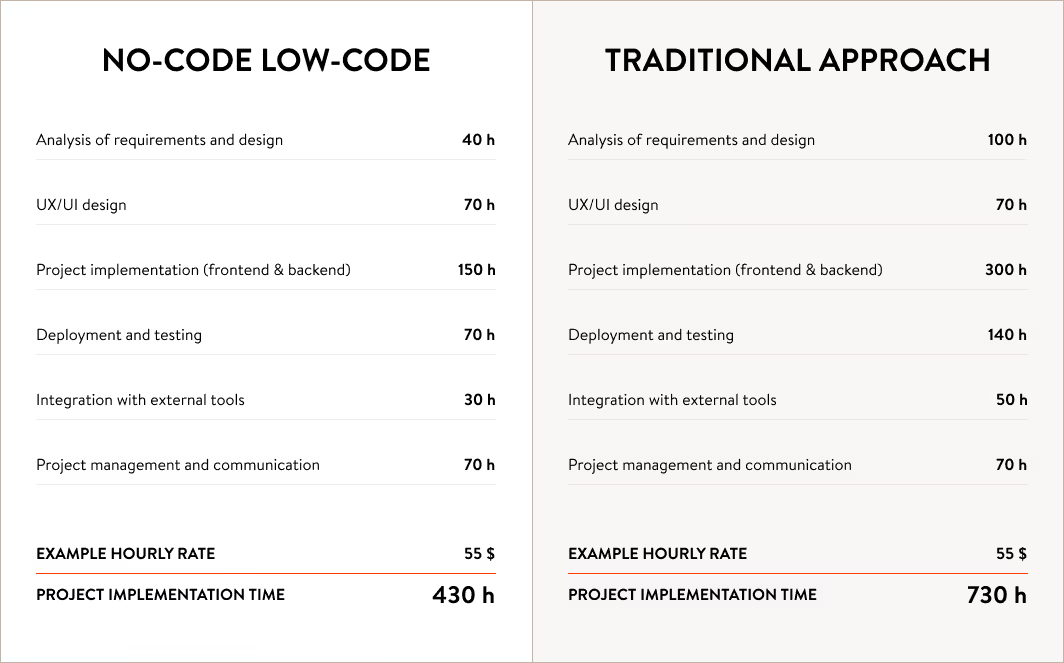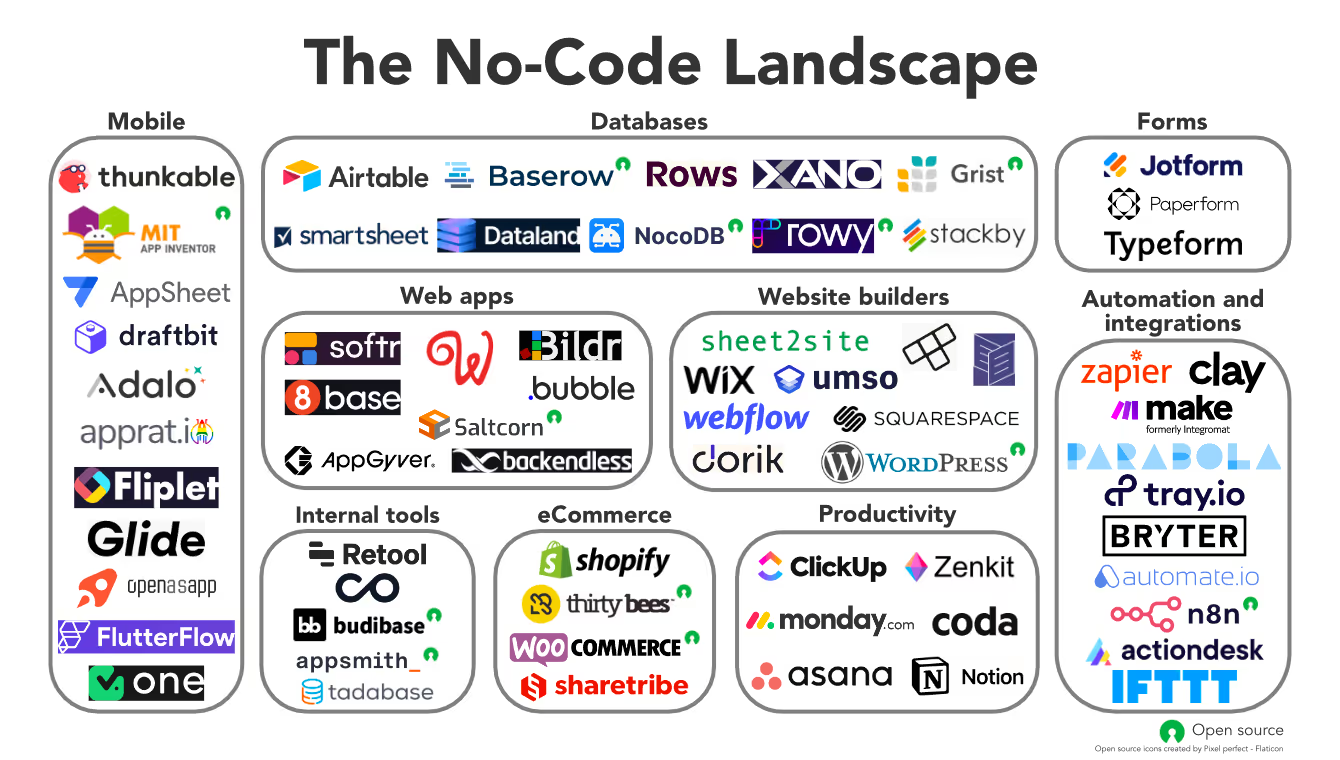Creating Software Has Never Been Easier
Especially when technologies such as AI and no-code low-code are available on the market. Although both innovations spark a lot of interest, many people still have doubts about creating software without using code (no-code) or with minimal use of it (low-code). What causes these doubts? Primarily, it's the very low awareness about no-code low-code technology. Therefore, in this article, we will analyze all the pros and cons of LCNC (no-code/low-code) technology and indicate which solutions are appropriate for this approach in software development. Discover the truth about no-code/low-code and see if it's the right technology for you and your needs.
What Are No-Code and Low-Code Technologies?
Although you probably already know what this technology is, we will start from the basics to delve deeper into the analysis. So, how do we define no-code and low-code?
No-code is a technology that allows for the creation of applications without writing a single line of code, while low-code minimizes the need for coding, still maintaining the possibility of its editing for more advanced functions.

Types of No-Code Low-Code Platforms
When building software in a LCNC approach, special platforms are used that enable the creation of specific functionalities. We distinguish between generally available no-code low-code platforms, such as Bubble, Webflow, or FlutterFlow, and Enterprise solutions: PowerApps, Mendix, or OutSystems.
The first group of generally available tools is designed in a very intuitive way, intended for a broad range of users and allowing for the creation of software with great ease. These are external tools that we can use at any time by purchasing access to them. They are mainly intended for small and medium-sized companies, as well as teams and departments within larger organizations.
On the other hand, Enterprise solutions are advanced systems that are mainly intended for large companies to create comprehensive internal solutions. Such platforms are integrated with the organization's existing systems and require significantly greater time and financial investment for their implementation.
Therefore, in this article, we will focus primarily on generally available no-code low-code solutions, like Bubble, Xano, Webflow, or FlutterFlow. They enjoy immense popularity precisely because of the comprehensiveness of the tools offered for rapid software development and significantly lower cost of their use.
That's the theory, but what does it look like in practice?
No-Code Low-Code in Practice - Speed of Software Development
Analyzing the pros and cons, we will rely on market data and our own years of experience. Let's start by examining the most popular asset of LCNC, namely the speed we gain compared to traditional programming.
Unfortunately, many enthusiasts of this technology get carried away in their calculations and indicate that LCNC can accelerate software development processes by even 10 times or even 15 times. Is this possible? Yes and no - let me explain.
The fact is that LCNC platforms allow for the acceleration of certain technical stages compared to traditional programming. However, they cannot significantly speed up the entire application-building process. Especially when we want to build comprehensive software or, for example, a polished MVP, and not just a barely functioning application.
So, how much does LCNC realistically speed up the software development process? By 40-50%! Which still represents a huge saving of time and money.
.avif)
This saving is primarily due to the optimization of technical stages, whose execution is indeed significantly accelerated by no-code low-code. However, when planning software development, it's also important to remember the other stages of the process, such as conceptual work, design, or testing. Here too, we gain some savings, thanks to LCNC allowing us to implement changes in much less time and more easily adapt the software to new needs compared to traditional programming.
Is No-Code Low-Code Expensive?
We've analyzed the time savings gained through no-code/low-code, but what does it look like financially?
This is the most difficult element to estimate, as it depends on many factors. Most importantly, who is creating the software and the cost of their services. It also depends on how complex an application we want to create and which LCNC tools and platforms we want to use.
These last two elements are strongly linked, as each LCNC platform has different packages and naturally, the larger the software we want to create, the higher the overall process cost will be. By how much?
Save with Greater Knowledge about No-Code Low-Code
The cheapest subscription for no-code/low-code platforms starts from a few dozen dollars per month. For basic solutions on a smaller scale, it's possible to achieve really low costs. In the case of more advanced solutions, it's worth getting a good understanding of the offers from LCNC platforms or consulting with experts, as the prices for hosting are higher here than with traditional infrastructure providers.
Moreover, when choosing a tool or platform, the first thing to check is whether the usage is associated with a cost per application or per user. This is one of the key factors that will verify the level of savings we can expect in the short and long term.
However, from experience, we know that even with larger applications or larger subscription packages, the entire cost associated with LCNC platforms is fully compensated with a significant surplus. How is this possible? Precisely due to the significant reduction in time and development cost.

Which No-Code Low-Code Platform is Best for You?
When planning to build software with no-code/low-code, it's always worth gaining full knowledge and being sure which platform, or sometimes even a combination of platforms, LCNC will be best for our solution.
Moreover, sometimes it turns out that the most effective way for development might be to combine, for example, traditional programming on the front end, with no-code technology on the back end. And such knowledge, about which approach to choose, is mainly possessed by experienced practitioners.

Check What Will Be Best for You
Observing the software development market for years and being well acquainted with this area, we can confidently confirm that no-code low-code technology is incredibly helpful and significantly simplifies the entire development process. However, it's indeed necessary to know how to use it and to keep up with trends, which change almost as rapidly as in AI.
Therefore, wanting to help every company considering using no-code/low-code, we offer a free consultation with our CTO - Kamil Tarczyński. During such a consultation, you will find out:
- if no-code/low-code is truly the best solution for your needs,
- which LCNC platforms will be best for building your IT projects,
- what to pay special attention to when planning the entire development process and competencies within the organization.
Kamil Tarczyński is a pioneer in the no-code low-code industry, who leads a team of developers on a daily basis, combining the world of traditional programming with LCNC technology. Possessing the most up-to-date knowledge on the market, he eagerly shares it and educates managers.
Sign up for a consultation by clicking the banner below and ask any question during the meeting about no-code low-code.

Security and Integrations with No-Code Low-Code
When we analyze concerns associated with LCNC, we cannot overlook some of the most common topics: security and integrations. These doubts are understandable since security should always be a top priority, and integrations are now indispensable elements of scalable applications.
So, what does this look like in practice for no-code low-code?
The Highest Level of Security
Let's start with the most important aspect - security. A few years ago, it became a common belief that no-code low-code was somewhat of a "toy" and more of a curiosity for creating simple applications, implying it wasn't fully secured. And although at the very beginning of this technology's evolution there might have been room for debate - today, we have arguments only in the opposite direction.
.avif)
Currently, no-code low-code platforms have become fully advanced platforms that implement rigorous security protocols and compliance with data protection standards. Moreover, most platforms clearly state which infrastructure they use, how it is secured, and what certifications it has. The most common certifications verifying their security include SOC-2, HIPAA, and ISO27001.
Of course, this still does not exempt developers from properly securing the application at its logical level (as opposed to the infrastructure level), such as by implementing appropriate RBAC policies in the database, hiding API access keys, etc. However, these are standard procedures that should always be remembered when creating software.
What Can You Integrate LCNC With?
In theory, building software with an LCNC platform limits us only to the capabilities that the given platform offers us. However, in practice, this is entirely untrue.
First, when building software, we can use several platforms at the same time. For example, a common combination is Bubble and Xano, where we combine a "front-end" platform with a "back-end" platform. Moreover, the Xano platform is also popular in combination with traditionally built fronts, which few people know if they only superficially treat the topic of no-code low-code.
Second, many no-code platforms offer advanced configuration options and the ability to extend functionality through add-ons or integrations with external APIs. Let's not forget that most of these platforms allow the addition of your own code, making their expansion possibilities almost limitless.
.avif)
What kind of integrations are we talking about? The most popular include payment gateways (like PayU, Przelewy24, Stripe), integrations with CRM systems (HubSpot, Pipedrive), external backend, artificial intelligence (ChatGPT, VisionAI), and many others that provide the aforementioned API interfaces.
If you have doubts in this regard, it may be the perfect topic to discuss during a consultation with Kamil Tarczyński.
Advantages of LCNC in Practice - Case Study
As you can see from the paragraphs above, no-code low-code technology is incredibly advanced today, offering numerous benefits. However, to illustrate this even better, we want to show you one of our case studies - the TaxRobot application.
You can read about the details of its construction process, the technology used, and other such things in the Case Studies - TaxRobot, to which we highly encourage you. However, we mention it here because it is an excellent example of an application that confirms the theses we have previously posited in practice.
.avif)
TaxRobot is an application that allows entrepreneurs to automate the process of obtaining tax credits for research and development activities in the United States, using artificial intelligence for this purpose.
It is an application performing complex calculations, using AI and automations, integrated with numerous external systems, full of proprietary plugins, but at the same time adhering to the highest security procedures on the US market. And most importantly, it operates smoothly and enjoys high usability.
And yes - the TaxRobot application was created 100% in no-code low-code technology, specifically on the Bubble platform, of which we are Silver Partners.
You can see our other case studies here: CASE STUDIES
Build Software with Professionals - Summary
If you're still considering using no-code low-code technology, we confirm - you're on a very good path to optimizing your processes, reducing costs, and becoming independent from the IT market situation. LCNC platforms are an excellent solution, but not for everyone!
As you've probably noticed in the article - it's essential to have a good understanding of the LCNC market and know how to use it, and the process of building competencies within an organization does take a considerable amount of time. Therefore, if you want to create your own application, website, or platform, or plan to strengthen your team's competencies, choose professionals who are essential at the beginning of your journey.
At havenocode, we not only create software, providing comprehensive services (design, development, testing, implementation, maintenance); but we also advise companies and entrepreneurs on how to build internal competencies or acquire the right specialists from the market.
Participate in a Free No-Code Low-Code Webinar
If you want to get answers to your questions as quickly as possible, we encourage you to take advantage of the consultations mentioned already. However, we're planning something special - a free no-code low-code webinar dedicated to entrepreneurs, managers, and IT decision-makers.
During the webinar, we will:
- Show the ins and outs of implementing LCNC in organizations,
- Dive into the specifications of platforms,
- Answer all participants' questions.
To participate, you need to sign up on the interested persons list by providing your email address on the registration page.
We will conduct the webinar after collecting a sufficient number of interested parties, and we will inform you about its date via email with a 2-week notice. So don't wait and sign up today, expressing your interest!

.avif)
%2520(1).avif)




-min.avif)

%2520(1).avif)













